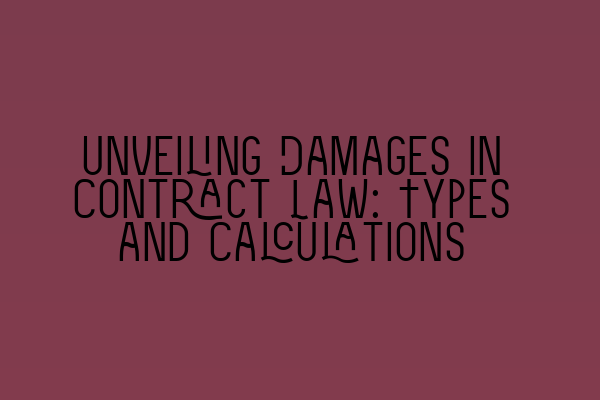Unveiling Damages in Contract Law: Types and Calculations
When it comes to contract law, damages play a significant role in rectifying any breaches or failures of performance. Understanding the different types of damages available and how they are calculated is essential for both solicitors and clients involved in contractual disputes. In this comprehensive guide, we will dive deep into the world of contract law damages, uncovering the various types and providing insights into their calculations.
Types of Damages in Contract Law
1. Compensatory Damages: Compensatory damages aim to put the injured party back in the position they would have been in if the contract had been fulfilled. These damages cover any financial losses resulting from the breach of contract, such as lost profits, extra expenses incurred, or the cost of replacing the goods or services promised under the contract.
2. Consequential Damages: Consequential damages, also known as special damages, go beyond compensating for direct financial losses. They arise from the consequences or “special circumstances” of the breach and aim to cover any indirect losses that flowed naturally from the breach. For example, if a contractor breaches a construction contract, consequential damages may include lost business opportunities or reputational damage.
3. Liquidated Damages: Liquidated damages are predetermined amounts mentioned in the contract itself. These damages are established during the contract formation stage, typically to compensate for a specific type of breach. They provide certainty to both parties and help avoid lengthy litigation by pre-determining the damages. However, it is essential for such damages to represent a genuine pre-estimate of the loss, rather than a penalty.
4. Nominal Damages: Nominal damages are symbolic or token amounts awarded when there has been a technical breach of contract, but no real harm or financial loss has been suffered. These damages, although small in value, serve to recognize that a breach has occurred and to establish the claimant’s legal rights.
5. Punitive Damages: Punitive damages, also known as exemplary damages, are awarded to punish the breaching party for their misconduct or to deter similar behavior in the future. However, it is important to note that punitive damages are generally not available in contract law unless expressly provided for in the contract or in exceptional cases where the breach involves fraud or malicious intent.
Calculating Damages in Contract Law
The calculation of damages in contract law strives to provide a fair and reasonable compensation to the injured party. The general principle is that the injured party should receive the sum of money that would put them in the position they would have been in if the contract had been properly performed. However, the calculation methods vary depending on the circumstances and the applicable legal principles. Here are some common approaches:
1. Expectation Damages: Expectation damages aim to put the injured party in the position they would have been in if the contract had been fulfilled. It calculates the financial difference between the value of the promised performance and the actual performance delivered due to the breach. This can include lost profits, the cost of cover (finding a substitute), and any other foreseeable damages resulting from the breach.
2. Reliance Damages: Reliance damages aim to compensate the injured party for the losses suffered due to their reliance on the contract. It calculates the expenses incurred in preparation for the contract or in performance of the contract before the breach occurred. This can include expenses like materials purchased, labor costs, or other costs expended in anticipation of the contract’s fulfillment.
3. Restitution Damages: Restitution damages, also known as disgorgement damages, aim to prevent the breaching party from profiting from their breach. It focuses on restoring the injured party to their pre-contractual position by requiring the breaching party to pay back any benefits or gains received as a result of the breach.
Each calculation method requires a careful analysis of the circumstances and thorough consideration of the nature of the breach and the losses suffered. It is advisable to consult with a solicitor experienced in contract law to ensure accurate and fair calculations.
Conclusion
Damages in contract law serve an essential role in compensating the injured party for losses suffered due to a breach of contract. Familiarizing oneself with the different types of damages and their calculations is crucial for both solicitors and clients involved in contractual disputes. By understanding the various approaches to damages and applying the appropriate calculation methods, solicitors can effectively represent their clients’ interests and achieve a fair resolution.
If you found this guide helpful, you may also be interested in reading these related articles:
- Barrister vs. Solicitor: A Comprehensive Comparison
- Embracing the Rise of Virtual Law Practices
- Unveiling Real-Life Case Studies: Insights into Legal Practice and Decision-Making
- Exploring Solicitor Salaries in the UK: Average Earnings and Factors Affecting Income
- Mastering Client Relationship Management: Skills for Solicitors to Enhance Trust and Loyalty
